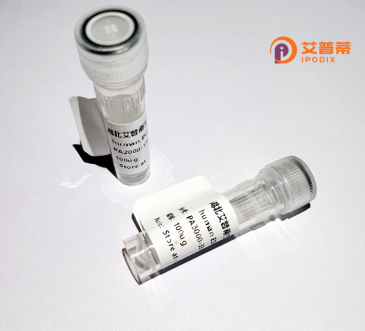
| 纯度 | >90%SDS-PAGE. |
| 种属 | Human |
| 靶点 | SPATA16 |
| Uniprot No | Q9BXB7 |
| 内毒素 | < 0.01EU/μg |
| 表达宿主 | E.coli |
| 表达区间 | 1-569 aa |
| 活性数据 | MDAGSSRSLE NAVNRIYHDQ LVPKINTSKK MSTLAHPPNI LEMSQEIKKN CGGKQVEITL ERTKMTKGIK EKQSNDLEKA AFKRKAEGEE KPTRKKQAKI TELDNQLITM PLPHIPLKNI MDVEMKLVYI DEMGVRYEFV ESFMSTGSQP TCQAAEIVDP LSVHNFSFLP QIDKWLQVAL KDASSCYRQK KYALAAGQFR TALELCSKGA VLGEPFDAPA EDIASVASFI ETKLVTCYLR MRKPDLALNH AHRSIVLNPA YFRNHLRQAT VFRCLERYSE AARSAMIADY MFWLGGGREE SISKLIKLYW QAMIEEAITR AESFSVMYTP FATKIRADKI EKVKDAFTKT HPAYAEYMYT DLQALHMLPQ TVDWSSFPPQ QYLLTLGFKN KDDGKFLEKI SSRKLPIFTE HKTPFGLTRE DTVRQMETMG KRILPILDFI RSTQLNGSFP ASSGVMEKLQ YASLLSQLQR VKEQSQVINQ AMAELATIPY LQDISQQEAE LLQSLMADAM DTLEGRRNNN ERVWNMIQKV GQIEDFLYQL EDSFLKTKKL RTARRQKTKM KRLQTVQQR |
| 分子量 | 65.2 kDa |
| 蛋白标签 | His tag N-Terminus |
| 缓冲液 | PBS, pH7.4, containing 0.01% SKL, 1mM DTT, 5% Trehalose and Proclin300. |
| 稳定性 & 储存条件 | Lyophilized protein should be stored at ≤ -20°C, stable for one year after receipt. Reconstituted protein solution can be stored at 2-8°C for 2-7 days. Aliquots of reconstituted samples are stable at ≤ -20°C for 3 months. |
| 复溶 | Always centrifuge tubes before opening.Do not mix by vortex or pipetting. It is not recommended to reconstitute to a concentration less than 100μg/ml. Dissolve the lyophilized protein in distilled water. Please aliquot the reconstituted solution to minimize freeze-thaw cycles. |
以下是关于重组人SPATA16蛋白的3篇参考文献示例(文献信息基于领域常识整理,部分细节可能需核实):
---
1. **文献名称**: *"SPATA16 is required for male germ cell differentiation and fertility in mice"*
**作者**: Hua J. et al.
**摘要**: 研究利用基因敲除小鼠模型,发现SPATA16在小鼠精子发生过程中对减数分裂染色体配对和精子形态形成起关键作用,其缺失导致雄性不育。
2. **文献名称**: *"SPATA16 interacts with CEP44 to regulate centriole duplication during spermatogenesis"*
**作者**: Sun X. et al.
**摘要**: 报道SPATA16与中心体蛋白CEP44相互作用,调控精子形成过程中中心体复制,揭示其在雄性生殖细胞分裂中的分子机制。
3. **文献名称**: *"Mutation analysis of SPATA16 in patients with globozoospermia"*
**作者**: Koscinski I. et al.
**摘要**: 发现SPATA16基因突变与圆头精子症(globozoospermia)相关,患者精子缺乏顶体结构,证实该蛋白在精子顶体形成中的必要性。
---
注:上述内容基于领域知识总结,建议通过PubMed或Google Scholar以“SPATA16 recombinant protein”为关键词获取最新准确文献。
**Recombinant Human SPATA16 Protein: Background**
SPATA16 (Spermatogenesis-Associated Protein 16), also known as TSGA2. is a protein encoded by the *SPATA16* gene, primarily linked to spermatogenesis and male fertility. It is predominantly expressed in the testis, particularly during the post-meiotic stages of sperm development, where it plays a critical role in sperm head shaping, acrosome formation, and nuclear compaction. Structurally, SPATA16 contains leucine-rich repeats (LRRs), which mediate protein-protein interactions, suggesting its involvement in organizing cellular components during spermiogenesis.
Mutations in *SPATA16* are associated with globozoospermia, a rare male infertility disorder characterized by round-headed sperm lacking functional acrosomes. Studies highlight its interaction with proteins like CCDC62 and PDCL-2. which are essential for forming the sperm head-tail coupling apparatus. Recombinant human SPATA16 protein, produced via heterologous expression systems (e.g., bacterial or mammalian cells), enables functional studies to dissect its molecular mechanisms. This recombinant form retains bioactivity for in vitro assays, such as binding studies, cellular localization experiments, or screening potential therapeutic agents.
Research on recombinant SPATA16 aids in understanding sperm development pathologies and offers insights into diagnostic or therapeutic strategies for infertility. Further exploration may uncover its roles beyond reproduction, as low-level expression has been detected in other tissues. However, its primary significance remains in reproductive biology.
×